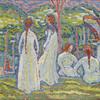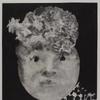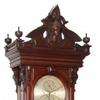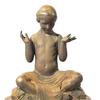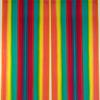Ancient Art Featured On The Curator’s Eye
- BOSTON, Massachusetts
- /
- April 10, 2014
The Curator’s Eye (www.CuratorsEye.com) turns its spotlight on the hundreds of ancient art and artifacts on offer through the online exhibition. The Curator’s Eye presents a worthwhile selection of rare, ancient objects from dealers based all over the world, from Roman silver to Chinese jade to Scythian gold.
Egyptian Azure Glazed Royal Shabti
This Egyptian azure glazed royal shabti for the Princess Nesy-Khonsu, from the 21st dynasty, ca. 1069-945 BC, is made of exceptional deep blue glazed faience, shown mummiform, and the features in applied black. The figure is slim and handsomely proportioned, with well modeled features including an unusually fine heart-shaped face with accented eyes and eyebrows, straight nose and a small, sweet mouth. She holds two hoes and carries a seed basket positioned at the back below the striated tripartite wig. Six registers of text wrap around the body and almost meet at the back, followed by the standard shabti spell from the Book of the Dead.
Early Roman Silver Skyphos and Neo-Assyrian Head of Pazuzu
Also available is an important early Roman silver skyphos with winged Erotes in Dionysiac revelry with torches, wine vessels and dogs. This piece, made between the 1st Century BC to 1st Century AD, has traces of original gilding. It joins a Neo-Assyrian Head of Pazuzu made of red serpentine stone from the 8th-7th Century BC. Amulets of the demon Pazuzu, son of the west wind, were worn by women in childbirth for protection against the female demon Lamashtu, who was feared for her attacks on newly born babies.
Eastern Chou Dynasty Jade Dragon Pendant
A pair of dragon plaques, from the Eastern Chou Dynasty in China, 700 to 500 B.C. are carved in brown jade streaked with white. This pair was part of a large pectoral assembly of a type known from burials. Found together, they are mirror images of each other and depict cutout dragon forms in profile, with indeterminate limbs, the front one of which seems to end in a bird head. The body is covered with raised bumps which have spiral swirls incised on them, which animate the surface, and must have demanded enormous amounts of time to reserve the high points and carve down and polish the background.
Pre-Columbian Sinu Gold and Bead Necklace
This striking and rare Pre-Columbian gold necklace was crafted by the Sinu people of Colombia, circa 600-1250 AD. The figural beads represent coatimundi, a much adored and frequently represented pet in many Pre-Columbian societies. The Sinu lived in the river valleys and along the Caribbean Coast of Colombia from around 200 to 1600 AD. They were most renowned for their elaborate irrigation and waterwork systems, their exquisite gold work, and the political significance of women in their social structure. Sixteenth century Spaniards were lured by the magnificence of the Sinu's ceremonial burial gold. Much of this gold was cast using the lost wax method but in other pieces, like this extraordinary necklace, the gold was fashioned into elaborate jewelry with refined skill and artistry.
Ancient Scythian Gold
These two ancient Scythian gold diadem elements from Western Asia, circa 2nd Century BC, are from an important Maotic-Scythian hoard, purportedly found near the Black Sea. They consist of a rounded, very fine belt tongue decorated with tiny granular balls and four garnet or carnelian embedments and a central medallion with ovular carnelian stone embedment and thick granulated border.
Etruscan Terracotta Antefix of a Goddess
This elegant Etruscan antefix from the Archaic period, circa late 6th- early 5th century BC, is distinguished by its remarkable craftsmanship. Many Archaic antefixes with female heads were directly inspired by eastern Greek art, but here the imprint of the Ionians is tempered by the influence of Athenian works. The attention to decorative detail is still very much in evidence, but the face is longer, and the modeling is more three-dimensional and less linear. As in Attic sculpture, the forehead is high, the cheekbones are clearly defined, and the almond-shaped eyes are more open and less narrow than in Ionian art.
During the Archaic period, the workshops at Caere, modern Cerveteri, in southern Etruria produced a large number of architectural terracottas designed to decorate sacred buildings. Antefixes had three functions: Placed on the eaves of the roof, they concealed the ends of the convex tiles and protected them from bad weather. They were also part of the architectural decoration. Finally, they had an apotropaic role, banishing bad luck and bad influences from temples. Made in molds and painted after firing, they usually took the form of a male or female face, such as this one.
Ancient Greek Gold Pendant Inset with Agate Cabochon
This Greek gold pendant, made circa 2nd Century BC, in Western Asia, has a large gold boss bordered loop hole pendant, set with a brown and white agate eye stone. The stone has a drilled perforation, where it was probably once used as a necklace element and reused in the pendant. The wide gold setting is decorated with raised circular elements with finely beaded borders.
Mayan Ceremonial Vase Representing Two Ball Players
A cylindrical Mayan ceremonial vase, from Mexico between 550-750AD, depicts a scene with two ball players facing each other on either side of a large rubber ball. One of the two protagonists is painted in ocher. He wears an important and elaborate headdress with a deer’s head. His opponent, whose body is painted in black, wears another headdress made up of a mythical animal’s head decorated with a stellar sign or Venus. Both characters also wear the traditional clothing of ball players. This vase, with its delicate and colored drawing, as well as its rich iconography, demonstrates the perfect mastery of the Mayan artists. This scene, drawn on the whole surface of the vase, demonstrates the importance of the ballgame in Mesoamerica, ritual game both popular and sacred.
Pair of Amphoras from Apulia, Magna Graecia
A nice pair of Apulian vases in terracotta from Apulia, Magna Graecia, in the 4th century BC display flared necks, semi-elongated belly and narrow bases on a piedouche, with two handles connecting the neck to the shoulder. They are Red-Figure on black with highlights of waterproof white paint. The neck is decorated with two lines of olive leaves. A palmette motif below each handle and a frieze of Greek motifs at the bottom of the belly frame the scenes.
These vases belong to the Bologne Group, and the iridescence of the black parts is the result of one of the three phases of what is known as firing “in reduced atmosphere,” when the black distemper coating on certain areas vitrifies and becomes shiny. Magna Graecia produced quality pottery comparable to that of Athens to the point the Greek cities would import many pieces of that kind from its Italian colonies.
The Curator’s Eye is the distinctive online platform for the finest art and antiques from distinguished dealers around the world. To view more exceptional ancient items, visit www.CuratorsEye.com.
Contact:
Leah TharpeThe Curator's Eye, LLC
8885995099
leah.tharpe@curatorseye.com
CuratorsEye@gmail.com
888-599-5099
http://www.curatorseye.com
About The Curator's Eye, LLC
A scholarly online exhibition connecting museums, collectors, and dealers with the finest art and antiques available on the market.




